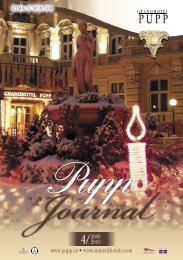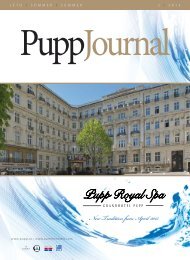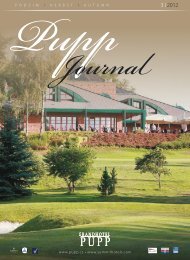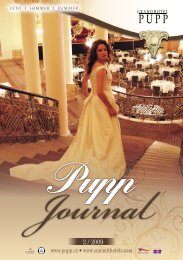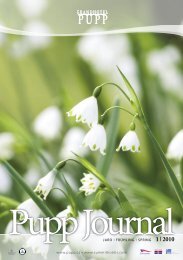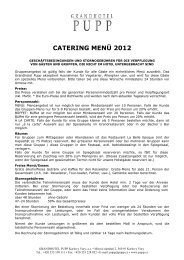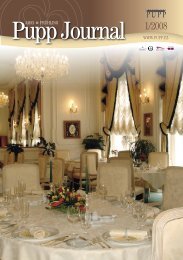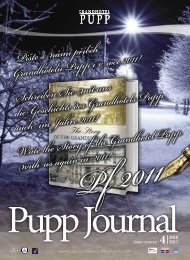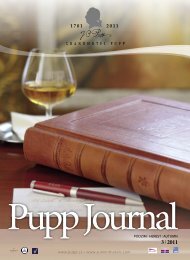2 I 2012 - Grandhotel Pupp
2 I 2012 - Grandhotel Pupp
2 I 2012 - Grandhotel Pupp
- TAGS
- grandhotel
- www.pupp.cz
Create successful ePaper yourself
Turn your PDF publications into a flip-book with our unique Google optimized e-Paper software.
HOW IS IT MADE?<br />
1 Malting<br />
2 Fermentation<br />
3 Distillation<br />
4 Ageing<br />
Continuation from the previous number<br />
2 FERMENTATION<br />
The sugary liquid is cooled to 22 – 24 °C and yeast changes sugar<br />
into alcohol. This process takes place prevailingly in special wooden<br />
containers (wash backs) whose volume is up to 700 hl and it takes<br />
two or three days. The result of fermentation is the transformation<br />
of the sugary liquid into a weak alcoholic solution similar to beer –<br />
that is why it is called beer or wash.<br />
Each distillery uses its special sorts of yeast (distiller’s or brewer’s<br />
yeast) which it grows. The type of yeast is kept secret – it is typical<br />
of each distillery. Huge containers are made of Oregon pine or<br />
Siberian larch. Lately they have started being made of stainless steel<br />
too. The smallest wash back is in Edradour (10 hl) and the biggest<br />
one is in Tamnavulin (more than 700 hl).<br />
3 DISTILLATION<br />
The resulting liquid contains about 6-9% of alcohol and goes<br />
through two stages of distillation which is controlled by a stillman.<br />
The first stage includes heating the containers closely under the<br />
boiling point which results into the separation of alcohol from<br />
the remaining liquid, yeast and non-fermented parts. Steam gets<br />
cool, condenses and low alcohol spirit is made. It is called low<br />
wines and contains 20 to 30% of alcohol. In the second stage, the<br />
cooled spirit continues into another, usually a smaller distillation<br />
unit (doublingstill, spiritstill). From here it goes to what is called<br />
alcohol safe through a cooling system. Its volume is measured in<br />
the safe. Only the middle fraction (heart of the run or middlecut)<br />
is always used in the proper distillation as it has the right strength<br />
and quality. The specialist’s task is to use his experience and feeling<br />
to tell the right moment when the best part of the distillate should<br />
be drawn off because it is crucial for the quality of whisky. Only this<br />
part of production is later used to age in barrels.<br />
The beginning – foreshots and the end - feinst contain some<br />
undesirable ingredients and are added to the following batch,<br />
mixed with it and prepared for new distillation. Distillation units<br />
are of different size – their volume can reach 40 hl like in Edradour<br />
or 300 hl like in Glenfarclas.<br />
Malt whisky is distilled with 65-80 % of alcohol (baby whisky)<br />
in the final stage, grain whisky with up to 94 %. The maximum<br />
is 94.8 alcohol by law, however, both sorts are diluted to about<br />
64 % which improves the quality of the ageing process in barrels.<br />
The whole process does not seem to be very productive from<br />
the outside – distilled whisky creates approximately a quarter of<br />
what you originally started to process. Scotch whisky is usually<br />
distilled 2x, somewhere 2.5x which means that only a part of the<br />
production is distilled for a third time to make it finer (Ardbeg,<br />
www.pupp.cz<br />
a THOUSand TaSTES OF WHISkY<br />
Benrinnes, Springbank) and triple distillation is carried out only<br />
in Auchentoshan today, it had been in the Rosebank Distillary<br />
too before it was closed down. Some distilleries on some islands<br />
distilled whisky even four times in the past to make it less heavy.<br />
The distillery in Bruichladdich is trying to do the same with a part<br />
of its production nowadays.<br />
Grain whisky is distilled continuously in two huge units. Most<br />
grain whisky is distilled twice, only the whisky in the most modern<br />
distillery Girvan is distilled three times.<br />
It is said that whisky must be in contact with copper (it removes<br />
undesirable sulphur) during the process of distillation, otherwise<br />
the final product will not be perfect. Jim Murray expressed it briefly:<br />
”The more the spirit is in contact with copper, the more distinctive<br />
the taste of the final product is and the heavier it is.”<br />
From the Big Book about Whisky by Vladimír Kulhánek,<br />
Dokořán (2007). To be continued.<br />
23



